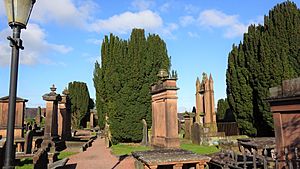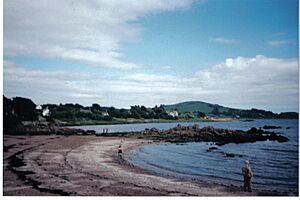John Lewars facts for kids
Quick facts for kids
John Lewars
|
|
|---|---|

St Michael's Graveyard, Dumfries
|
|
| Born | 1769 |
| Died | 1826 Dumfries
|
| Occupation | Excise Officer and Land Surveyor |
John Lewars (1769–1826) was a government officer who collected taxes (called an excise officer) and a land surveyor. He was a good friend and colleague of the famous Scottish poet Robert Burns when Burns lived in Nithsdale and Dumfries. Around 1793, John moved with his sister Jessie Lewars to a house in Millhole Brae (now Burns Street). Their house was right across from Robert Burns's home in Dumfries. Jessie Lewars was a very close friend of the Burns family. She helped them a lot, especially by looking after Robert when he was sick before he died. She also helped with housework and cared for the children.
Contents
John Lewars's Life and Family
John's father, also named John Lewars, used to be a supervisor for the excise office in Dumfries. He passed away in 1789. John Lewars junior had two sisters, Mary and Jessie. Mary married a local builder named William Hyslop.
In 1799, John Lewars married Barbara Howe from Gretna. They had two children together.
John Lewars died at Ryedale Cottage in Troqueer when he was 57 years old. He was buried in St Michael's cemetery in Dumfries. His grave is near where Robert Burns was first buried.
John Lewars and Robert Burns's Friendship
Robert Burns was ten years older than John Lewars. Burns called Lewars "a special friend of mine" and "a young man of amazing talent."
It is thought that Burns wrote a playful poem in 1796 about one of John Lewars's crushes. The poem talks about a young woman named 'Woods' who "stole" Lewars's heart. Burns wrote that her looks had a magical effect on him. Lewars also admired Jean Lorimer, who was known as Burns's 'Chloris' in some of his poems.
|
The Hue and Cry of John Lewars A thief, and a murderer! Stop her who can! While I looked at her eye, for the devil is in it, Her, features, I'll tell you them over - but hold! But softly - I have it - her haunts are well known, |
After Robert Burns passed away, John Lewars took on many important tasks. He wrote letters to friends and family to tell them the sad news.
Lewars wrote a letter to Mrs. Dunlop the day after Burns died, on July 22, 1796. This letter is the only proof that Frances Dunlop had finally replied to Burns's many unanswered letters.
"Madam, At desire of Mrs Burns I have to acknowledge the receipt of your letter, and at same time to inform you of the melancholy and much-regretted event of Mr Burns's death. He expired on the morning of the 21st., after a long and severe illness. Your kind letter gave him great ease and satisfaction, and was the last thing he was capable of perusing or understanding. The situation of his unfortunate widow andfamily of most promising boys, Mrs Dunlop'sfeelings and affection for them will much easier paint than I can possibly express, more particularly when Mrs Dunlop is informed that Mrs Burns's situation is such that she is expected to ly-in dayly. I am certain that a letterfrom Mrs Dunlop to Mrs Burns would be a very great consolation, and her kind advice most thankfully received."
Lewars also wrote to William Nicol to tell him about Burns's death. Nicol replied later, explaining he had been ill.
John Lewars also joined Robert Burns in the Royal Dumfries Volunteers. This was a group of local citizens who volunteered to help defend their area. They joined at their second meeting in January 1795. John Syme, Burns, and Lewars were all part of the Second Company of these volunteers.
John Lewars's Career
Working as an Excise Officer
John Lewars became an excise officer, also known as a gauger, in Linlithgow in December 1789, when he was twenty years old. In 1799, Lewars was moved to the 1st Itinerancy, which was Burns's old route. This job involved traveling about two hundred miles each week on horseback. Records also show that Lewars was told off in 1795, but the reason is not known.
Lewars, Burns, and another officer named Walter Crawford were involved in an event with a ship called the Rosamond on January 29, 1792. This ship was used by smugglers in the shallow waters of the Solway Firth. When the ship got stuck, Lewars and Crawford were sent to Dumfries to get more soldiers to help. The ship's goods were still on board. There is a story that Burns bought four small cannons from the ship's sale and tried to send them to the French army. A man named Joseph Train is said to have gotten papers about this event from Lewars's widow. He then gave them to Sir Walter Scott. The papers written by Lewars that described the cannon story have not been found. However, a search of old records found a list of the ship's items written by Lewars. This list included sails, masts, ropes, and furniture, along with a short summary of how much money they made at the auction.
When Burns was working as a temporary supervisor for the Excise, Lewars took over Burns's usual duties. Another officer, Adam Stobie, covered Lewars's area.
Around April 1792, John Lewars was on a list of excise officers who were considered to be better than average at their job. His colleagues, Robert Burns, Walter Crawford, and William Penn, were also on this list.
After leaving the Excise for a while, Lewars returned to work. He worked as a relief supervisor in different places: Kincardine on Forth in 1817, Linlithgow in 1817, Dunkeld in 1818, Inverary in 1818, and Montrose in 1819. Finally, he worked in Dumfries from 1820 to 1824. He then retired with a yearly payment of £160.
Land Surveyor and Farming
In 1807, after he first left the excise service, John Lewars rented Lauder Farm in Caerlaverock. However, by 1817, he had gone back to work for the Excise.
John Syme, a mutual friend, described Lewars as a Land Surveyor. It was common for excise officers to have a second job to earn more money. It seems Lewars added to his income by doing surveying work. A document in the Dumfries Burgh Records mentions a "Proposal by J. Lewars for publishing a map of the Town and Borough Roads of Dumfries" in 1796. A map of the River Nith from 1808, drawn by Lewars, is kept at the National Library of Scotland.
See also
- Robert Aiken
- Jean Armour
- John Ballantine
- Lesley Baillie
- Alison Begbie
- Nelly Blair
- Isabella Burns
- May Cameron
- Mary Campbell (Highland Mary)
- Jenny Clow
- Gavin Hamilton (lawyer)
- Helen Hyslop
- Nelly Kilpatrick
- Jessie Lewars
- William Nicol
- Anne Rankine
- Isabella Steven
- Peggy Thompson



